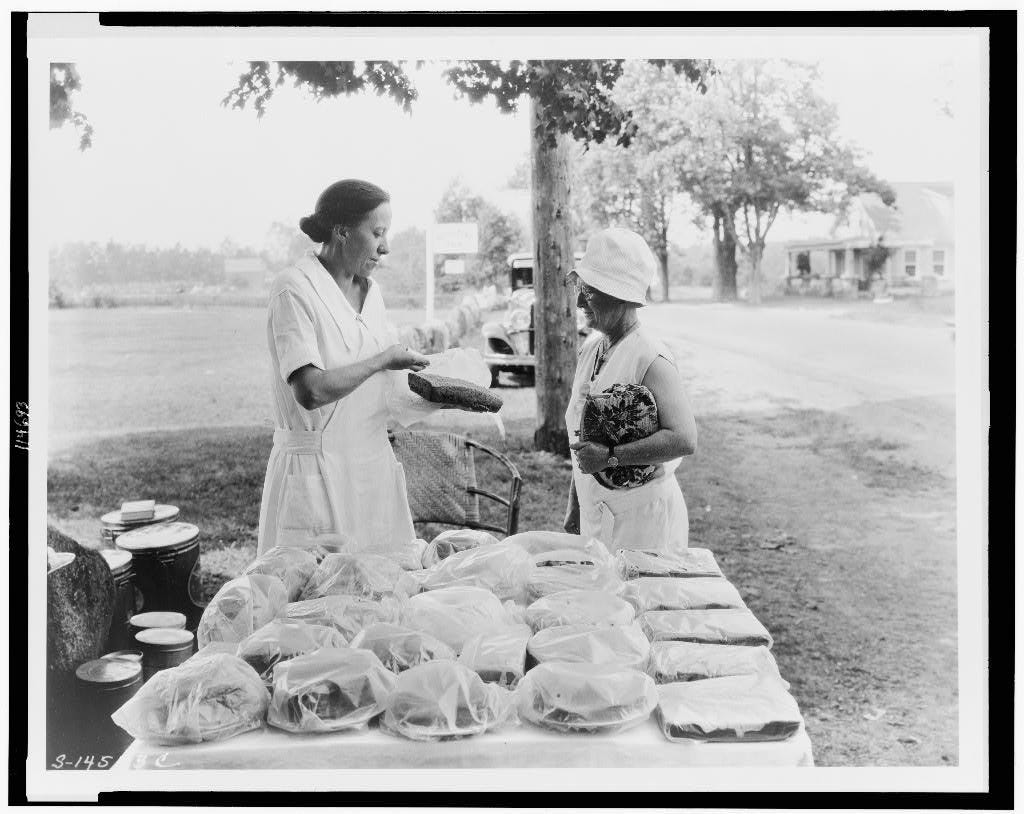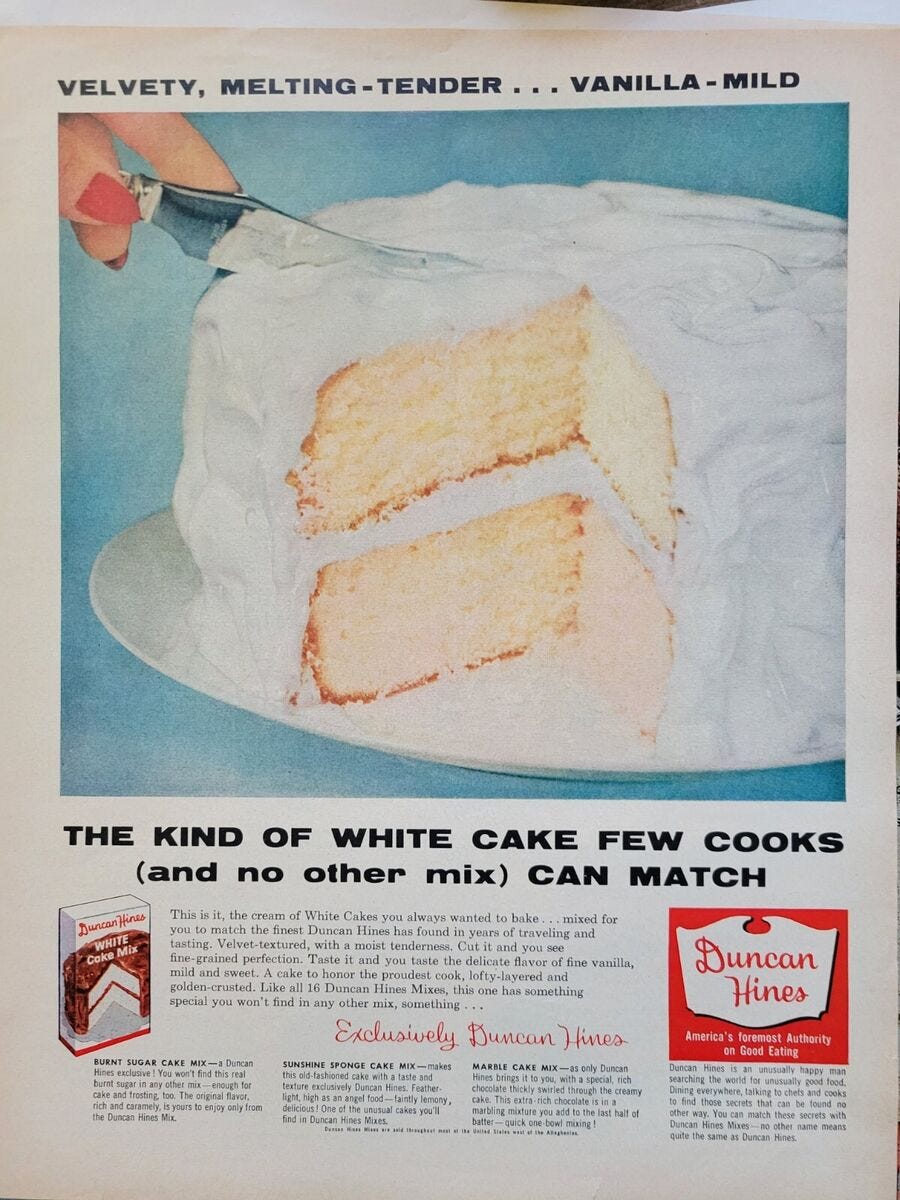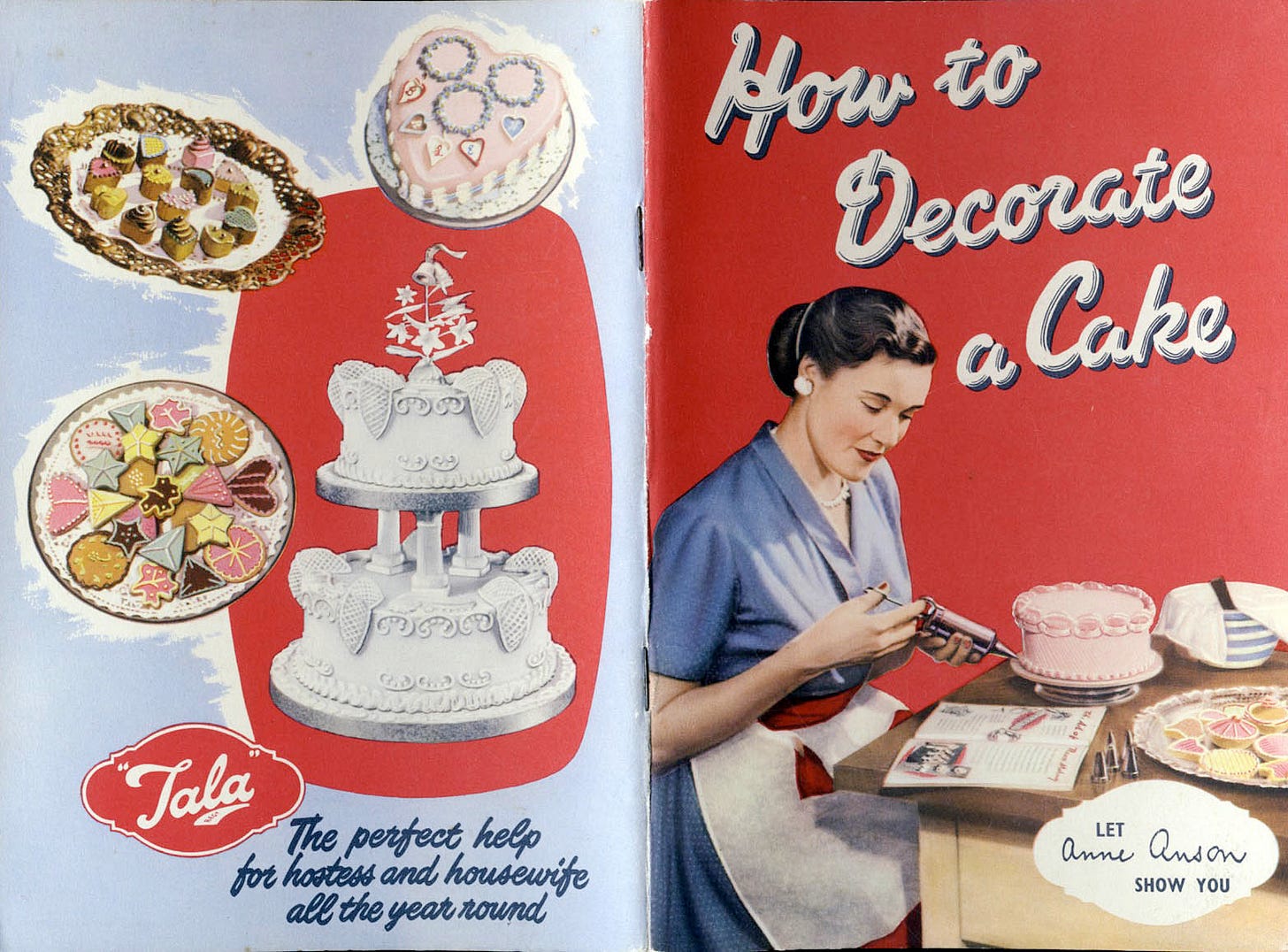Not a week goes by now it seems without some sort of online cake drama. While I’ve been attempting to avoid social media this summer, I couldn’t ignore the recent drama served up by the op-ed piece “Enough With the Ugly Cakes” in The Cut. A handful of folks familiar with my cake expertise made sure I saw the piece and I’m grateful that they did.
I know cakes. My grandmother was a professional home wedding cake baker and taught me most of what I know about baking and about the baking business. My graduate work turned into a close study of cakes and their cultural implications. I’ve written a lot about cakes and I’m currently working on a book about the cultural feminist history of cake, having studied cakes, bakers, and baking related socioeconomics and legal issues related to cottage baking in the United States. In my professional and academic opinion, the author of that article does not know cakes.
I won’t cover the baking logistics or the author’s misunderstanding (or at the very least lack of acknowledgement) of the costs of running a contemporary custom bakery. You can read wonderful breakdowns and discussions about those mishaps written by bakers including Comrade Biscuit and Pastry Parade (I’m sure there are other great takes, please share them in the comments below). I also loved yesterday’s response from my friends over at Cake Zine (a publication that really understands and does great research on cake!). Instead, I’m going to focus on the sociocultural and historical inaccuracies of the “Ugly Cake” article.

Cake shaming is not only weird, but such a strange use of energy. Yet it’s exactly the kind of thing our society tends to do to anything related to pleasure, especially when it’s created for or by a woman. (I’ll spend another post waxing about the sensual pleasure connection between the revival of vintage-inspired cakes and the rise of the historical/historically-inspired female POV Romantasy genre.) Bottom line: We do not yuck other peoples’ yums. The fact that the author has reduced the glorious diversity of cake aesthetics into two categories of “Ugly Cakes”—“vintage monstrosities” or “floral slop”—is lazy data collection and simply unkind.
Although the author was writing an opinion piece and entitled to their preferences, there’s a lot of power in the written word. Notably, this same author has also written multiple articles filed under the “POWER” column at The Cut covering important topics including bans on trans athletes, the syringe attacks in France, and pieces on domestic violence against women. The use of disparaging language like “shapeless mounds” alongside direct links to bakers’ websites and Instagram feeds are potentially libelous and definitely cruel, especially when those links take you to sites, such as the brilliant Yip.Studio, that are full of examples of technically-difficult cake shapes that are not only logistically arduous to cut, frost, and decorate, but decidedly boundary-breaking in design. Further, the use of “inedible flora” on cakes isn’t a new Instagram trend, but a practice bakers (and consumers) have been navigating for decades. Bakers like Frosted Hag, whose cake aesthetic utilizes copious florals and is precisely the reason people seek out her work, include notes about the non-edible (but “safe to be in contact with the cake”) flowers she uses.
The Rise of Cake Culture
As commenter “shopgirl1111” so eloquently pointed out in the comments of the article, “can we really credit the pandemic & out of work bakers with the spread of “whimsical, outlandish” cakes? I feel like they’ve been steady on the social media scene since the Ace of Cakes & Cake Boss…” “Shopgirl1111” is spot on, as our cultural obsession with ornate cakes has been brewing long before the pandemic and many in the Baking Community have been working to revive vintage styles and techniques for years. Based on the article, it seems the author only started paying attention to cakes during the pandemic, when they “had lots of time on [their] hands and very little to celebrate and Instagram was one of our last lifelines to human connection.”
The truly problematic issue isn’t the timeline or who came first, rather that women are the ones baking this time. Ace of Cakes and Cake Boss are both men with their own brick-and-mortar bakeries. The bakers criticized by the author largely identify as women. Additionally, many operate out of their homes under far more precarious cottage baking operational structures.

Here We Go Again, Devaluing Baking Labor
The pandemic did result in numerous out-of-work bakers and industry folks who pivoted to baking out of their homes in lieu of other unavailable restaurant work. Shortly after this societal shift, there was a massive and long overdue revamp of the cottage baking industry—meaning food made in a home kitchen for sale—and related laws which vary from state to state. Historically, cottage baking laws have disproportionately impacted women who are more likely to be working out of their homes while also dealing with domestic labor as well as childcare. These laws, while theoretically important for maintaining safe and clean working conditions for products that will eventually be sold to consumers, also create unnecessary regulatory burdens and have historically crafted a stereotype of cottage bakers as unsafe and unskilled. The concept of unskilled labor is a classist, and often sexist, trope.
The author argued: “I’m not saying these cakes don’t require skill, artistry, and impressive amounts of labor to create. But beneath all the branches and glitter, they’re often just not that good. (It makes sense: They’re made to be seen or even stabbed on SNL; taste is low on the priority list).”
It doesn’t matter what they do with the cakes. As baker The Sweet Feminist has explained repeatedly on her Instagram, the cakes can be dessert, a medium for messaging, or none of your business unless you ordered it. At the end of the day, the cake required highly skilled labor.
Boxed Cake Redemption
Another issue the author had with the cakes was the flavor, exclaiming that “everything tastes suspiciously like boxed vanilla.”
Presumably, the author is referring to the taste of boxed cake mix. Boxed cake mix flavors may not be for everyone, but they are plenty of peoples’ preference as evidenced by decades of boxed cake mixes lining grocery store shelves and other bakers’ dedicated attempts to reproduce those flavors from scratch in their own kitchens. Boxed cake mix has a long history of being disparaged as a cheat, a shortcut, a “less-than” option used by “unskilled” bakers. In reality, bakers, professional and otherwise, often utilize cake mixes in some form. They also acknowledge that boxed cake mix flavor profiles have a perfectly acceptable place in our cultural foodways. Ultimately, hating on boxed cake mix and those who use them is classist.
Later, the author says: “Give me a big honking square of grocery-store sheet cake from a Stop & Shop fridge.” That is boxed cake mix. Most grocery store cakes are made from boxed cake mixes, and thus have the “boxed vanilla” flavor plenty of people prefer and that’s just fine. We all like what we like.
Enough with Lambeth
When describing the cakes, the author explains that “They’re covered all over with thick, Lambeth piping, a 1930s decorating style characterized by intentional excess to create layers and dimension.”
Lambeth is a method, not a style. Joseph A. Lambeth was a man who got good at teaching other people how to do overpiping. He published his book, The Lambeth Method of Cake Decoration and Practical Pastries in 1934, but the techniques he covered had existed for generations before he came on the cake scene. Other methods include the still-popular Wilton method, the Ateco method, and the methods championed by the UK’s Anne Anson who worked with the brand Tala in the 1950s. They’re all teaching methods for overpiping, which is a very delicate, highly skilled technique that demonstrates frosting can be used to create depth and intricacy—not just excess.
These cakes aren’t all Lambeth, and they aren’t all vintage! They are a culmination of decades, centuries, generations of baking methods and skills and aesthetics distilled into numerous reimaginings of our current cake preferences.

And One Last Thing
The author sets up a real apples to oranges situation with her final argument: “Whatever happened to the unassuming torte, the trusty cheesecake, the good old bundt?”
A layer cake isn’t tiramisu and tortes are incredibly assuming (see: Dobos torte above) and deservedly so. Those delicious little cakes typically call for a special springform pan and require multiple pastry techniques in a single recipe (sponge, caramel, mousse, buttercream) and are just as complex as one of the cakes disparaged by the author. Comparing complex American cakes with equally complex European tortes is asking for a complicated geocultural bakeoff along with an in-depth discussion of the evolution of baking traditions and global trade history (which we’ll have to save for another newsletter).
In my opinion, it really sounds like the author just doesn’t like cake, and that’s just fine. Want to know a secret? I also sometimes (often) don’t like cake and would rather have a cookie or a slice of pie (don’t tell my grandma). But I respect the work put into a cake—be it from the grocery store baking counter or from your neighbor hustling in their little apartment kitchen. No one needs cake, its very existence denotes its specialness. A cake baked was made with intention, skilled labor, and because someone somewhere had an idea of what would bring them joy and someone else found a way to bake it into reality. That could never be considered ugly.








I love that you didn't link to the op-ed. Let's not give it anymore attention. (Linking to small businesses criticising them without giving them right of reply is low. And then she failed at Tiramisu! A relatively simple dessert comparatively)
Yours is a wonderfully researched piece I thoroughly enjoyed. Thank you.
Fantastic piece!
Do you know of Allison Chenny on IG (@al.chenny), I think she's also here on Substack, who was shamed so much for the cakes she was taking to the Cake Picnic events that she decided not to share cakes anymore? It's wild.